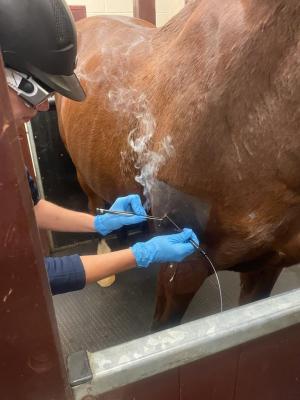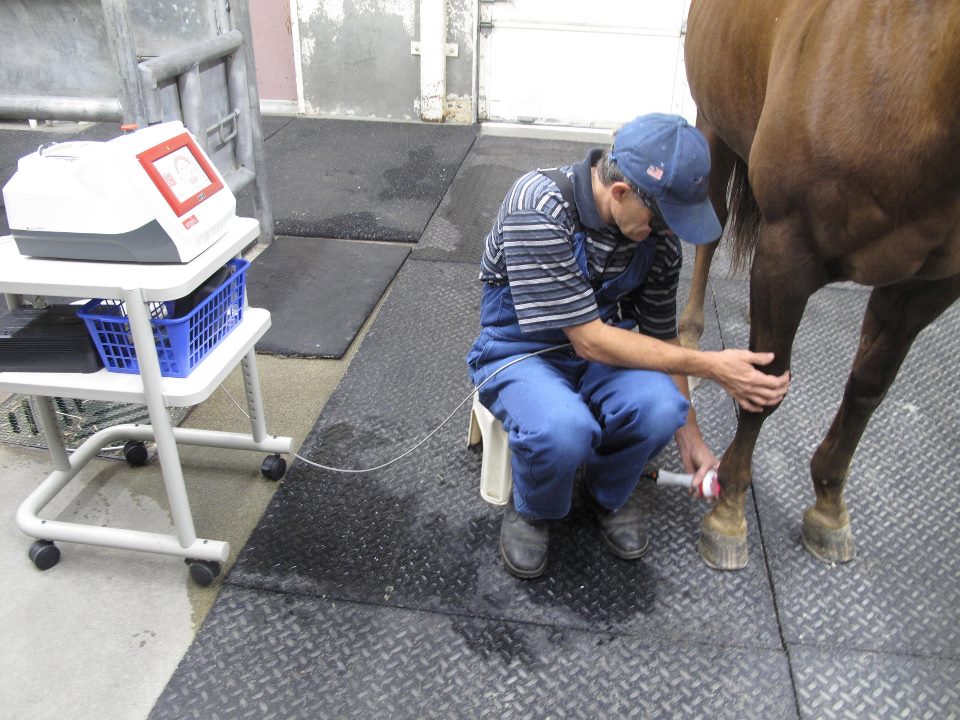Equine Therapy for Children: Emotional and Behavioral Assistance Clarified
Equine Therapy for Children: Emotional and Behavioral Assistance Clarified
Blog Article
How Laser Treatment in Equine Therapy Is Transforming Veterinary Take Care Of Horses
Laser treatment has become a transformative technique in equine vet treatment, offering a non-invasive service that speeds up recovery and improves general health and wellness. Leveraging exact light wavelengths, this sophisticated therapy boosts mobile regrowth, lowers inflammation, and alleviates discomfort. Its efficacy prolongs from musculoskeletal injuries to chronic ailments like osteo arthritis, dramatically boosting wheelchair and life top quality for steeds. The mobility and flexibility of laser therapy tools additionally underscore their growing necessity amongst veterinarians. As we explore the elaborate auto mechanics and real-world successes, the profound effect on equine medical methods comes to be progressively obvious.

Comprehending Laser Treatment
Understanding laser treatment is essential for appreciating its duty in equine treatment. Laser therapy, also called photobiomodulation, entails the application of certain wavelengths of light to tissues, which can result in numerous organic results. This healing method utilizes the power of light energy to permeate the skin and underlying tissues, stimulating mobile processes and boosting cells repair.
The modern technology behind laser therapy is grounded in the principle of photochemistry, where photons are taken in by chromophores within cells, causing raised ATP production and modulation of responsive oxygen varieties. This, subsequently, promotes cellular proliferation, reduces inflammation, and accelerates recovery. Vet practitioners make use of different kinds of lasers, including low-level lasers (LLLT) and high-power Class IV lasers, depending upon the particular therapeutic objectives and the nature of the equine problem being dealt with.
Various laser wavelengths and power settings are carefully chosen to target various cells depths and achieve wanted medical end results. Safety and security methods are extremely important, as improper use can bring about thermal damage or suboptimal healing effects. Therefore, a detailed understanding of laser treatment's systems and applications is crucial for its reliable implementation in equine veterinary practice.
Benefits for Horse Health And Wellness
The myriad advantages of laser therapy for equine wellness encompass boosted recovery, discomfort reduction, and enhanced flexibility. This sophisticated therapy modality leverages particular wavelengths of light to permeate cells, promoting mobile function and promoting fast tissue repair service. The non-invasive nature of laser therapy ensures minimal tension and pain for the equine, promoting a smoother recuperation process.

By minimizing swelling and discomfort, and enhancing cells repair, laser therapy assists in restoring joint feature and muscular tissue flexibility. Therefore, laser therapy stands as a transformative device in contemporary equine veterinary care.
Usual Problems Treated
Laser therapy has actually emerged as a functional therapy choice for a range of typical equine conditions. Furthermore, laser therapy is reliable for conditions like osteo arthritis, where it aids mitigate joint swelling and promote tissue repair work.
Wound management is one more location where laser treatment has actually revealed substantial promise. Persistent injuries or slow-healing abscess can be especially challenging in steeds, yet laser treatment boosts cellular regeneration and improves blood circulation, therefore quickening the recovery procedure. Moreover, laser treatments have actually been effectively used in managing unguis problems such as laminitis and abscesses, reducing pain and advertising much faster recovery.
Horse professional athletes often deal with performance-related issues like muscle soreness and tension fractures. Laser treatment aids in lowering muscular tissue exhaustion and speeds up the recovery of micro-injuries, thus guaranteeing that horses go back to peak performance quicker. By resolving these varied conditions, laser treatment is transforming the landscape of veterinary care, offering a non-invasive, reliable alternative to conventional therapies.
Innovation Behind Laser Therapy

Laser tools made use of in veterinary medication frequently use low-level laser therapy (LLLT) or chilly laser therapy. Unlike high-powered surgical lasers, these devices run at lower energy degrees, enhancing restorative benefits while minimizing thermal damages. The power from the laser light stimulates adenosine triphosphate (ATP) production, boosts mobile metabolism, and increases cells repair work procedures.
Modern laser therapy devices for equine treatment is created with flexible settings to cater to the particular needs of different tissues and conditions. Additionally, advancements in laser technology have actually led to the advancement of mobile, handheld gadgets, making it less complicated for vets to offer treatment in a variety of setups, from facilities to stables.
Success Stories and Instance Researches
Showcasing the substantial advantages of laser treatment, many success tales and situation research studies brighten its transformative influence on equine health and wellness. One such situation includes a pure-blooded racehorse suffering from chronic tendonitis. Standard treatments generated marginal improvement, yet after incorporating laser treatment right into the program, the equine displayed significant decreases in inflammation and discomfort within weeks, eventually returning to competitive auto racing.
Another compelling example includes a dressage horse diagnosed with serious pain in the back, limiting its performance. A veterinary team used low-level laser therapy (LLLT) to target the swollen locations, leading to significant improvement in versatility and a remarkable decrease in discomfort. Over numerous sessions, the steed regained its peak form, showcasing the efficiency of laser treatment in resolving musculoskeletal problems.
Additionally, a research study performed at a leading equine facility checked out 50 steeds with different soft tissue injuries treated with laser treatment. The outcomes stood out: 85% of the steeds demonstrated increased recovery times and improved wheelchair. These cases highlight the flexibility and effectiveness of laser therapy in equine medication, offering a non-invasive, scientifically-backed technique to enhancing recuperation and additional reading efficiency in horses.
Conclusion
Laser therapy is revolutionizing equine veterinary treatment by offering a non-invasive therapy that increases healing, decreases inflammation, and alleviates pain. With its efficiency in treating a variety of conditions, from musculoskeletal injuries to persistent ailments like osteo arthritis, this innovation significantly improves equine health and wellness and flexibility. The portability straight from the source and flexibility of laser treatment additionally emphasize its transformative effect on vet methods, solidifying its role as an important device in modern equine health care.
Report this page